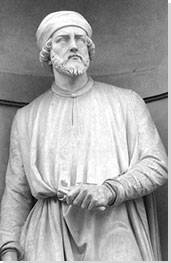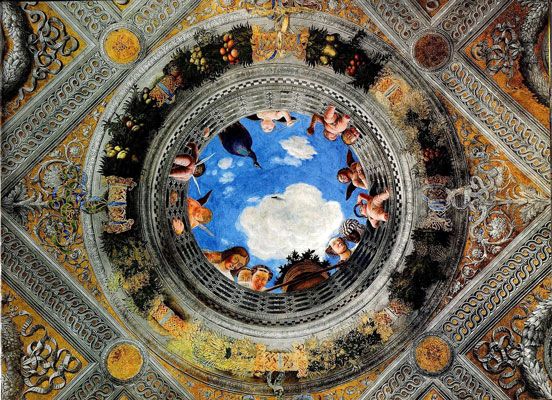Summary of Donatello
Donatello would become known as the most important sculptor to resuscitate classical sculpture from its tomb in antiquity, through an invigorated style that departed from the Gothic period's flat iconography. He broke ground by introducing new aesthetics in line with the time's flourishing move toward Renaissance Humanism - a movement that emphasized a departure from medieval scholasticism and favored deep immersion into the humanities, resulting in art that no longer focused solely on the secular realm of religion but explored man's place in the natural world. Donatello's signature lifelike and highly emotional works would place him as one of the most influential artists in 15th century Italy, and an early forefather to the Italian Renaissance.
Accomplishments
- Donatello's work was highly influenced by the revival of interest in the sciences, mathematics, and architecture that was taking place in Florence. This included the use of one point perspective to create a new kind of bas-relief for architectural works and a precise anatomical correctness for his figures.
- The figure was a central point of mastery for the artist, and he was in fact the first to reintroduce the nude sculpture. With the addition of realistic proportion, emotionality, and expression to his subjects whether they be mythic, historical, or everyday people, he created works that conveyed a genuine reality over the idealized imagery of before.
- Donatello was a prolific master of many mediums including stone, bronze, wood, stucco, clay, and wax. He was the first to illustrate the art of sculpture among the modern artists. His versatility and ingenuity would lay a foundation for many future sculptors looking to discover new possibilities in materiality.
The Life of Donatello

Fiercely exclaiming "Speak, damn you, speak!" as he sculpted, Donatello created The Prophet Habakkuk (1423-25). Celebrated for its radical realism, the Early Renaissance masterpiece also prefigured later movements.
Important Art by Donatello
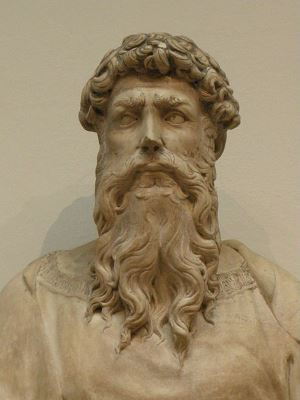
Saint John the Evangelist
The precise date for this early work by Donatello is not known, but between 1408-1415 the artist worked on this large-scale marble figurative sculpture depicting Saint John the Evangelist. Typically depicted as a young man, Donatello decided to portray the apostle as an aging prophet, holding the Bible, which was a departure from legend toward a more humanizing rendition. While the top half of the sculpture still represents an idealized point of view, the subject's facial expression is carefully considered, and the sculpting of the legs and hands points to a more realistic figuration. Donatello pays attention to the anatomy of the saint's legs, even though they are hidden under his robes, demonstrating a new preoccupation with representing the body with accuracy and naturalism. The work was displayed in a niche in the façade of the Duomo Cathedral in Florence, a project that brought together works by some of the city's most important artists over the course of two centuries.
This sculpture is seen as an important step away from the Gothic style that predominated in Florentine (and European) art at this point. Moreover, Donatello shows a new understanding of the requirements of perspective, compensating for the fact that viewers would see the sculpture from below and therefore making the body disproportionately longer than the legs. As the curator and art historian Daniel M. Zolli points out, Donatello was aware that the base of the sculpture would be set approximately four feet above human height: "Not only are John's proportions far closer to nature when observed from this angle, but his presence is much more formidable: the fabric of his raiment hangs heavily from the frame of his body, and the whole composition organizes itself into a stable pyramid."
Marble - Museo dell'Opera del Duomo, Florence
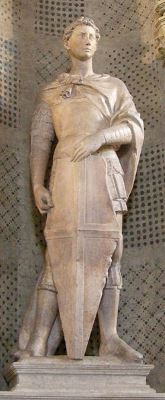
St George
Donatello was commissioned by the swordmakers' and armorers' guild to carve this sculpture of their patron saint, St. George, for a niche on the exterior of the church of Orsanmichele in Florence. The work is a life-sized depiction of the saint standing atop a marble panel which is carved to illustrate the famous mythical moment when George slayed the dragon. Although the work was meant to reflect the Florentine spirit of holding strong against all adversaries, Donatello's meticulous rendering of the emotionality of the face also betrays a distinct vulnerability and softness. This expertise in portraying emotion, as is also seen in his equestrian statue of condottiero Erasmo da Narni, was a signature technique of the artist toward humanizing subjects that would traditionally be presented in a more idealized fashion.
The work marks an important moment in the development of sculpture because Donatello brought back the ideals of classical sculpture and married them with a new realism, departing boldly from the prior Gothic mannerism. The marble panel at the base is also an important work of art in its own right. It is a key early example of a bas-relief made using the principles of linear perspective, which was infiltrating painting at the time. The shift from empirical perspective to linear perspective is one of the key discoveries that contributed to the development of Renaissance art. Donatello would have been familiar with the experiments with perspective drawn by his friend Brunelleschi, and his skill was to apply them to the challenging medium of bas-relief carving.
Marble - National Museum of Bargello, Florence
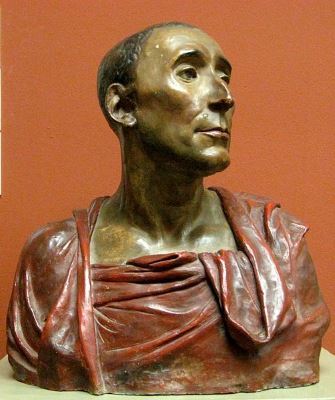
Bust of Niccolo da Uzzano
Niccolo da Uzzano was an important figure in Florentine politics in the early decades of the 15th century, who acted as a respected intermediary figure between the city's powerful rival families. Donatello produced the bust (although its authorship is sometimes contested) soon after Uzzano's death in 1433. It was the first half-bust of a private citizen produced since antiquity.
Donatello's use of carefully molded terracotta clay, the unusual facial expression, and the choice of polychrome paint all suggest that this was intended to be an accurate portrait of an individual, rather than an idealized image representing an abstract concept of leadership or virtue. Donatello's craft emphasizes Uzzano's humanity and personality in a way that had not previously been seen, or felt credible in art. Yet alongside the Humanist movement in Florence at the time, artists were transitioning to a more authentic rendition of people, whether royal or plebian, that emphasized genuine expression.
The Florentine Renaissance expert Irving Lavin argues that presenting the figure as a half-bust is key to its power and highlights Donatello's revolutionary approach. By cutting off the figure at the bust and avoiding traditional presentation on an elaborate plinth, Donatello suggests that this is a true portrait, and a mimetic representation of a real human being: "The arbitrary amputation specifically suggests that what is visible is part of a larger whole, that there is more than meets the eye. By focusing on the upper part of the body but deliberately emphasizing that it is only a fragment, the Renaissance bust evokes the complete individual - that sum total of physical and psychological characteristics that make up the "whole man"."
Painted terracotta - National Museum of Bargello, Florence
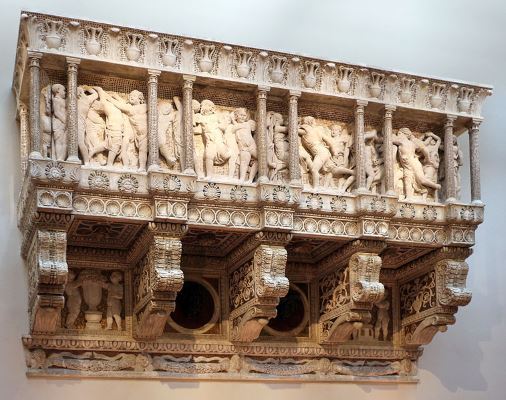
Cantoria
In the early 1430s, Donatello's friend and peer, Brunelleschi, was finalizing his ambitious design for the dome of Florence Cathedral. The Opera del Duomo, which was the body responsible for decorating and maintaining the building, turned its attention to interior decoration. They commissioned Luca della Robbia to design one of the internal organ lofts, and then, in 1433 when Donatello returned from Rome, they immediately commissioned him for the other.
Donatello's project contrasted greatly with della Robbia's. Whereas della Robbia's divided the cantoria's panels into separate scenes illustrating the different verses of Psalm 150, Donatello's consisted of a continuous narrative that flowed around the three visible sides of the loft. This resulted in a sense of animation and movement for the viewer. What also made his work innovative was its inspiration taken directly from the classical friezes and ancient sarcophagi he had encountered in Rome.
The work also reflects Donatello's mastery of sculpture and his signature techniques, cultivated to manipulate the viewing experience. As the art historian Timothy Verdon notes, "the sculptor's design took carefully into account his cantoria's principle light source: mere feet below the work was a group of torches and candles elaborately ordered atop an architrave". Instead of polishing the marble to a customary sheen, Donatello left parts rough so that when hit by the candlelight coming up from below, various shadows, textures, and points of luminosity would add another element to the overall composition. It is interesting that Donatello took such pains over the materiality of marble in this work, as it was the last major commission that he completed in this medium.
Marble - Museo dell'Opera del Duomo, Florence

David
This small but exquisite bronze is one of Donatello's most famous works. It is a five foot, freestanding bronze sculpture of David, from the classic story David and Goliath. He stands in contrapposto, a traditional classical stance of bearing more weight on one leg than the other. Instead of being depicted as a powerful man, he is presented as a young, nude boy wearing an unusual hat wreathed with laurels (a motif of victory), and a pair of elaborately gilded boots. This unconventional arrangement, combined with the figure's long hair, delicate features, and slim figure make the work a provocative, coquettish and effeminate piece. Another strange factor is that one wing of Goliath's helmet is considerably longer than the other, and points up the figure's leg to the groin. The work has been a key touch-point for arguments over Donatello's sexuality.
These speculations aside, Donatello's David is important both in technical terms and in terms of the artist's treatment of his subject matter. It was the first free-standing male nude sculpture produced since antiquity, and controversial for a non-pagan, biblical figure. Beyond the bold reintroduction of the nude in art, art historian Dr. Beth Harriet also pointed out about this Early Renaissance period, "sculpted figures have finally been detached from architecture and are once again independent in the way that they were in ancient Greece and Rome. And because he's freestanding, he's more human, more real. He seems able to move in the world, and of course the contrapposto does that too. It's easy to imagine this figure in the Medici palace garden, surrounded by the ancient Greek and Roman sculpture that they were also collecting." Indeed, due to its small stature and location, the statue was designed to evoke an intimate experience for visitors of the family.
Bronze - Bargello Museum, Florence
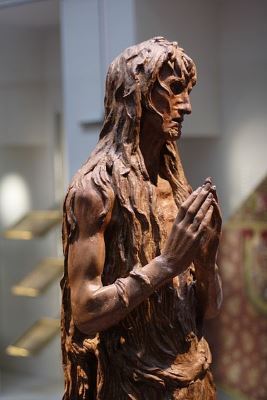
Magdalene Penitent
Donatello's life-size depiction of Mary Magdalene wandering through the desert in penitence is one of his most moving works. The level of realism and emotionality achieved by the artist was unprecedented. Like with many of his works, Donatello veered from legend and preconceived notions about his subject and depicted Magdalene as an old, starving woman rather than the more common young and beautiful nude fed by angels. He cloaked her in either her own hair or a hair shirt, emphasizing her complete renouncement of her former life as a prostitute. Even though, art historian Bess Bradfield points out, "The bare flesh of the saint is exposed as much as it is hidden by this hair..."
In this work, Donatello emphasizes the humanity of biblical characters, presenting Mary Magdalene as a relatable figure to be pitied and admired on a human level as a well as idolized on a saintly level. The use of wood demonstrates Donatello's facility with multiple materials, and in this stunning choice, the grain of the wood helps to create the agonized texture of the saint's skin. The work was also painted, adding an unprecedented level of detail and realism, especially seen in the whites of the eyes and the pupils.
The 16th century biographer Giorgio Vasari saw this work when it was situated in Florence's Baptistery, and he commented: "a statue from Donatello's own hand can be seen, a wooden Saint Mary Magdalene in Penitence which is very beautiful and well executed, for she has wasted away by fasting and abstinence to such an extent that every part of her body reflects a perfect and complete understanding of human anatomy."
Painted wood - Museo dell'Opera del Duomo, Florence
Biography of Donatello
Childhood
It is common thought that Donato di Niccolo di Betto Bardi (generally known as Donatello) was born in 1386 in Florence to Niccolo di Betto Bardi. However, the date is conjectural, based on a declaration of income submitted by the artist in 1433, stating his age at 47. He received his childhood education in the house of the Martelli family, one of Florence's richest families.
Donatello's father was part of the wool guild Arte della Lana, which was one of seven major guilds in 14th century Florence. Florence's system of governance was nominally democratic, with the guilds playing an important role in the running of the city. The guild was headquartered in the Palazzo dell' Arte della Lana, which was linked by a gallery to the church of Orsanmichele, a former marketplace whose transformation into a church was paid for by the city's guilds. The church's exterior ornamentation would later provide Donatello one of his most important commissions.
Early Training and Work
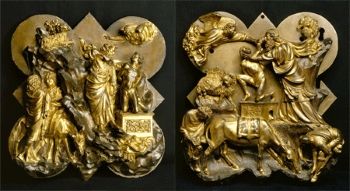
Like other Florentine sculptors such as Lorenzo Ghiberti and Benvenuto Cellini, Donatello received his early artistic training in the workshop of a goldsmith. His first major exposure as an artist arrived when he competed for the famous 1401 competition for the design of the Baptistery doors in Florence. Afterwards, he worked for a brief period of time in the studio of Ghiberti, winner of the Baptistery door competition, whose influential workshop provided training for a number of young artists.
From 1402-1404, Donatello studied with his friend and colleague Brunelleschi. According to Brunelleschi's biographer Antonio Manetti (who wrote his account during the life of both artists), the pair travelled to Rome, where they excavated and studied the ancient ruins there. This time marked the beginning of the Humanist movement in Florence, which favored the classical art of ancient Greece and Rome over the stiff and formal style of the Medieval and Gothic periods. Donatello and Brunelleschi were the first to systematically study ancient ruins for inspiration. Donatello funded this time of artistic exploration by working as a goldsmith.
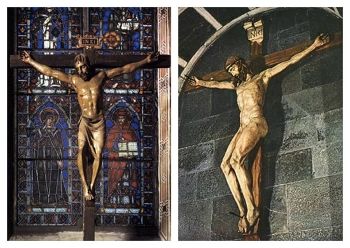
In his influential account of Renaissance Florence, Lives of the Artists (1550), Giorgio Vasari specifically highlights the friendship between Brunelleschi and Donatello. Although some historians now doubt the attribution of dates, Vasari tells the story of Donatello carving a wooden crucifix for the Santa Croce church (now dated to c.1412-13). The lifelike and moving work depicted Christ as a real rather than idealized figure, with an emotionality and expression in direct opposition to the customary flat iconography of the time. This was revolutionary and would become a key characteristic of Early Renaissance artists. This led Brunelleschi to say that Donatello had carved a peasant. In an attempt to do better, he carved his own wooden crucifix (now dated to c.1410) and invited Donatello over for dinner, casually leaving his work displayed "in a good light." When Donatello came in, he dropped the food he was carrying, causing Brunelleschi to ask, "What are you about, Donatello? How are we to dine when you have dropped all the things?" "I," said Donatello, "have had enough. If you want anything, take it. To you it is given to do Christs, and to me peasants."
The first clear historical reference to Donatello is found in 1406, when he received a payment for a work of sculpture. Between 1406 and 1408, Donatello also assisted Ghiberti with statues for the north door of the Florence Baptistery. He was then commissioned to execute the large-scale figure of Saint John the Evangelist, which he worked on between 1409 and 1411, a work which significantly marked the transition in art from the late Gothic to the Early Renaissance.
After the success of this work, Donatello began to receive more significant commissions, including two important sculptures for the guild church of Orsanmichele, which had been a noted part of his childhood. He became known as the first sculptor during this period to utilize the new concepts and techniques derived from the Early Renaissance period's incorporation of mathematics, science, and architecture into art including one point perspective, anatomical accuracy, and even created a signature form of bas-relief for his carvings to emphasize depth and three-dimensionality. He also collaborated with other artists, including Michelozzo with whom he worked on a funerary monument, once again in Florence's Baptistery.
Mature Period
Around 1430, Donatello found himself under the patronage of Cosimo de' Medici, the head of the most powerful family in Florence which was known to be a great patron of the arts. Cosimo commissioned the artist to produce a bronze sculpture of David (a symbolic figure for the city of Florence), which resulted in the first free-standing nude statue made since antiquity.
Some critics have speculated, because of the perceived homoerotic elements in Donatello's David, that Donatello himself may have been gay. Very little is known about Donatello's personal life, but he never married or had children. Anecdotes attributed to Angelo Poliziano in 1480, sometime after Donatello's death, infer that Donatello had eroticized relationships with his apprentices, claiming that he employed only beautiful young men and "stained" them so that no one else would want them.
In 1433, Cosimo de'Medici was imprisoned and then exiled from Florence by a faction of rival families. In the absence of his patron, Donatello travelled to Rome and reinforced the classical influence on his work. He returned to his home city the following year, along with Cosimo, and began work on projects for Florence's Duomo and the cathedral in nearby Prato. This marked a period of significant maturity and success for the artist. As Vasari recalled, "He was most liberal and courteous, and kinder to his friends than himself; nor did he care for money, keeping it in a basket hanging from the ceiling, where his workmen and friends could help themselves without saying anything to him."
Late Period
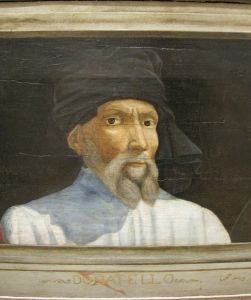
Although he had worked in Florence for most of his life, in 1443 Donatello was summoned to Padua in order to sculpt a funerary monument for the condottiero Erasmo da Narni, who was known as Gattamelata (honey-cat). His equestrian statue was the first of its kind since antiquity. Although the work was well received in Padua, Donatello insisted on returning to Florence.
He spent the rest of his years there, setting up a workshop with apprentices, where he continued to receive financial support from Cosimo de' Medici. According to Vasari, when Cosimo died, he asked his son Piero to continue to care for Donatello, and Piero accordingly gave Donatello a farm in Cafaggiuolo. However, although the artist was initially pleased, he found the rural life too domestic for him, so he returned the land and received a monetary allowance instead, and "passed all the rest of his life as friend and servant of the Medici without trouble or care."
The Legacy of Donatello
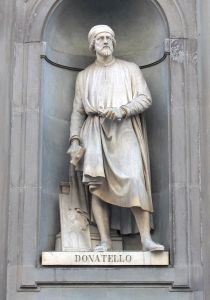
Donatello and his innovations in perspective and sculpture during the Early Renaissance contributed greatly to the overall foundation of what would become the flourishing Italian Renaissance. This included the earliest recognized works of Renaissance sculpture, which moved firmly away from the late Gothic style that had predominated before. His revolutionary work, particularly in his representation of the human body, would go on to inspire the early Italian Renaissance painters, including Masaccio, whose paintings in the Brancacci Chapel in Florence in particular mark a turning point for pictorial art in Europe. Donatello also made a significant mark in Padua, where he worked briefly, particularly on Andrea Mantegna (1431-1506), who was an important figure in the development of the Venetian Renaissance. He influenced and taught a number of sculptors, including Nanni di Banco.
Donatello's place in history was affirmed by Vasari in particular, who claimed, "He may be said to have been the first to illustrate the art of sculpture among the moderns." His appeal has been long lasting, even making its way into contemporary popular culture. For example, as the namesake to one of the Teenage Mutant Ninja Turtles alongside other Renaissance stars Michelangelo, Leonardo, and Raphael.
Influences and Connections

-
![Filippo Brunelleschi]() Filippo Brunelleschi
Filippo Brunelleschi - Michelozzo
-
![Andrea Mantegna]() Andrea Mantegna
Andrea Mantegna - Michelozzo
- Desiderio da Settignano
- Andrea del Verrocchio
-
![Filippo Brunelleschi]() Filippo Brunelleschi
Filippo Brunelleschi - Bertoldo di Giovanni
- Desiderio da Settignano
